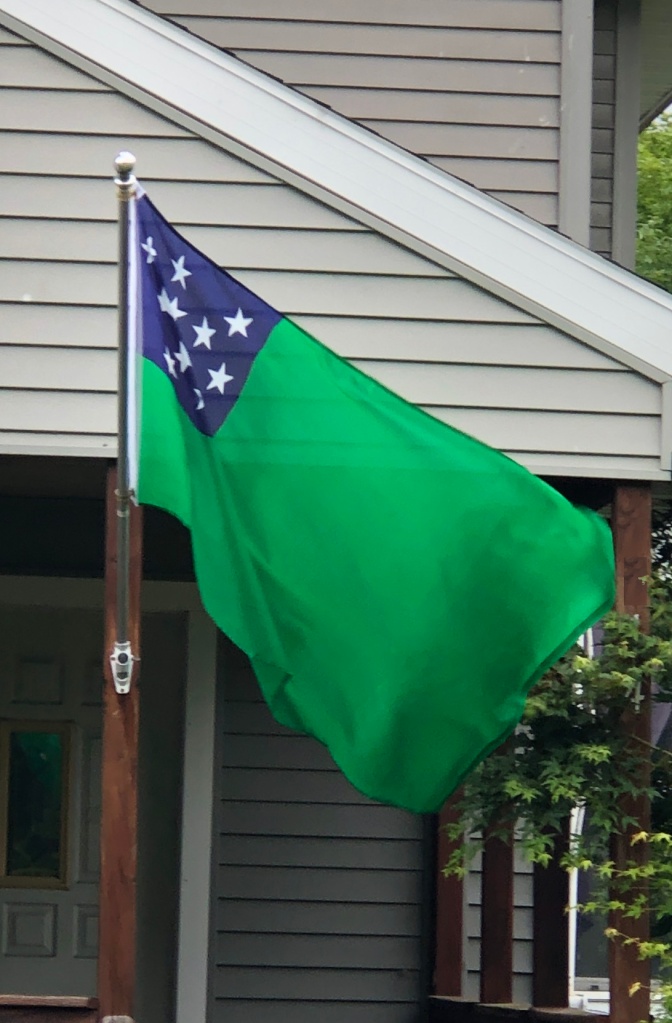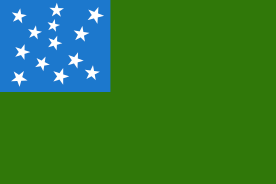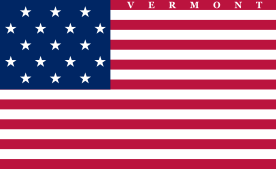
Happy Flag Day 2023!
I thought about starting this post by pondering the efficacy of having recurring columns on a blog and, well, a job, but it seems like I began the last installment, written, in part, on Flag Day last year, with just that sort of disclaimer. I’ll try to pick up the pace.
We’re flying the flag of “the Green Mountain Boys” this year which is possibly the most recognizable regimental flag of the Revolutionary War. It was likely flown at the Battle of Bennington in 1777 by John Stark.
At least, there is a fragment of a flag that was flown by Stark at that battle in the Bennington Museum. It’s the canton of the flag with what appears to be remnants of green silk on three sides. But the flag as we have it today is a reconstruction; its connection to the Green Mountain Boys and its relation to Vermont are disputed.

Other sources suggest that The Green Mountain Boys’ flag was the unofficial flag of the Vermont Republic and served as the unofficial state flag from Vermont’s admission to the union in 1791 to 1804.
So, how does this fit into our series on State Flags? If you recall our first installment, we’re dividing the US state flags into four categories
- Flags that need no changes
- Flags that only need very slight changes
- Flags that have well-established, aesthetic alternatives and
- Flags that require significant changes.
The Green Mountain Boys’ flag fits firmly into category three even if its early history is unclear. Multiple proposals have tried to revert the design of the state flag to the Green Mountain design, but none have been successful. That though is enough for me to consider it a “well-established” alternative.
Is it aesthetic? I think so, even if it is a bit bland. The thirteen stars in a “natural arrangement” sets it apart from other flags with stars in the canton and the green field is appropriate for the “Green Mountain State.” I won’t list them here but it easily clears the NAVA’s five principles of good flag design.
Consider the history of the Vermont flag. The Green Mountain Boys’ flag was the unofficial state flag from Vermont’s admission to the union in 1791 to 1804 when Vermont’s “second state flag” was adopted. There were 17 states at this time and the designers decided that adding stripes as well as stars was still a pretty neat idea (it wasn’t), this banner consists of 17 stars and 17 stripes. To distinguish this from a theoretical national flag, “Vermont” is written across the uppermost stripe. The third state flag, adopted in 1837, reverted to thirteen red and white stripes but had a single eight-pointed star in the canton, surrounding the pastoral scene from the center of Vermont’s coat-of-arms. On 1 June 1923, almost exactly 100 years ago, Vermont their current flag, consisting of the state coat-of-arms on a field of azure.




Among the three official state flags, two are strikingly similar to the United States flag (or perhaps Liberia’s). The third is a classic seal on a bedspread. While the Green Mountain Boys’ flag isn’t necessarily the quintessential flag for the state of Vermont, in this company it is the clear choice.
References:
- Flag of Vermont accessed 14 June 2023
- Flag of the Green Mountain Boys accessed 14 June 2023
- New Vermont State Flag Proposal accessed 14 June 2023
- John Stark accessed 14 June 2023
- The Controversial Green Mountain Boys accessed 14 June 2023
- The Green Mountain Boys & The Evolution of Vermont’s State Flag accessed 14 June 2023
Image Credits:
- Featured And Second Images: (c) 2023, ComicsTheUniverseAndEverything.net
- Historic Flags from Wikimedia Commons

